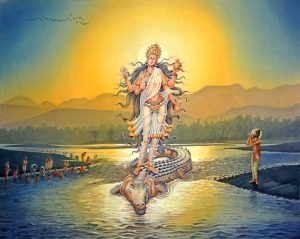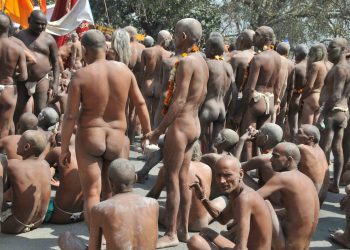
A king named Sagara was born in Ikshavaku’s lineage. He possessed beauty, character and strength and was powerful. But he did not have a son. He had two wives who were proud of their beauty and their youth. One was from Vidarbha and the other from Shibi. Desirious of obtaining a son, the king performed great austerities, together with his wives, seeking refuge on Mount Kailasa. While he was engaged in great austerities and immersed in yoga, he saw the great souled
Shiva, Uma’s consort, the one with many forms.As soon as he saw that granter of boons, the mighty-armed king, together with his wives, prostrated themselves and asked for a son. Hara was pleased and told the supreme among kings and his two wives, ‘O king! Considering the moment when you have asked me for a boon, sixty thousand brave sons who will be proud in war will be born to one of your wives. O supreme among men! One son will be born to the other wife. O king! But they will all be destroyed together. But you will have one brave descendant from the one who bears the single one.’ Having spoken these words, Rudra instantly vanished. King Sagara also returned to his residence with his wives, happy in his heart.
Keshani gave birth to a gourd. Sumiti gave birth to a son who was as beautiful as the gods. The king then thought about throwing away the gourd. But he heard a voice from the sky, deep in sound. ‘O king! Do not act in haste. Do not abandon your sons. Take the seeds out from the gourd. Let them be carefully preserved in a warm vessel partly filled with ghee. O king! You will then obtain sixty thousand sons. O lord of men! Mahadeva has decided that your sons will be born in this fashion. Do not make your mind act contrary to this.’Sixty thousand sons were born to the rajarishi through Rudra’s grace. They were terrible, the performers of cruel deeds and could travel around in the sky. Since they were many in number, they oppressed all the worlds, even the immortals. Addicted to fighting, they
oppressed the thirty gods, the gandharvas, the rakshasas and all other beings.
The valorous King Sagara instated himself for a horse sacrifice. Protected by his sons, his horse roamed the earth.But Indra, the head of the Devas, felt insecure after seeing Sagara growing more powerful than him. Hence to disrupt Sagara’sYagya, Indra stole the horse and hid it at Sage Kapila’s hermitage. After learning that the horse has gone missing, King Sagara asked his sons to go in search of it. After exploring every nook and corner, they found it at Sage Kapila’s ashram, who had been in a deep state of meditation and oblivious of its presence.
On seeing the horse, they shivered with delight. Driven by destiny,they showed no respect for the great-souled Kapila. Desirous of grabbing the horse, they dashed towards it in anger. Kapila, supreme among sages, was angered at this. He opened his eyes wide and created energy from them. That immensely energetic one burnt down the sons of Sagara.Having seen them burnt to ashes, the great ascetic Narada went to Sagara and told him. On hearing these terrible words from the mouth of the sage, the king was distracted for a moment. He reassured himself and summoned his son’s son, Anshuman, the son of Asamanjas.
After many years Anshuman discovered the remnants of his ancestors near the still meditating sage, and asking for forgiveness and release from the curse pleaded to Kapila to suggest a way to liberate his ancestor’s trapped souls. He suggested that it can only be done by sprinkling ‘Gangajal’ or the holy water of the Ganga over the ashes and hence help them achieve moksha or salvation. But for that to happen one had to go through strict penance and request Lord Brahma to let Ganga out of his kamandalu ( a water-pot used by saints) to let her flow to earth.
Anshuman began with the penance but failed to invoke Lord Brahma, then his son Dilip went further with it to meet the same fate. In order to bring peace in the kingdom the kings could not help but perform the penance, then Dilip’s son Bhagirath began with the penance leaving his kingdom to his ministers.
King Bhagirath was the epitome of hard work and wisdom, he undertook tougher ways and after thousands of years of strict penance, he finally succeeded in invoking Lord Brahma and requested him to release Goddess Ganga to come down to earth in order to cleanse his ancestors’ cursed soul. At this, Lord Brahma suggested that Ganga cannot be brought to earth directly from heaven as her truculent flow will bring havoc to earth. Brahma suggested Bhagirath invoke Lord Shiva to help him further.
After successfully invoking Lord Shiva, Bhagirath asked for his help in bringing Goddess Ganga down to earth without any mass destruction.
When Ganga was released from Brahma’s Kamandalu to fall on earth, Shiva spread his serpentine locks of hair over the entire earth to protect it and confined her fierce flow in his serpentine coils. After her rigorous efforts and Bhagirath’s plead to fulfill the cause, Shiva let her flow out in different streams to spread her on the entire earth. That is how the Goddess Ganga received its many names and Shiva came to be known as Gangadhara.
Goddess Ganga then followed behind Bhagirath and on her way entered Sage Jahnu’s hermitage and made him wet, disturbing his deep meditation. He, out of rage, drank all her water and stored it in his body. Bhagirath, on discovering the series of events that took place in the hermitage, explained the cause of Ganga’ arrival on earth to Jahnu and asked him to release her. Jahnu then released her through his ear and hence Goddess Ganga received her name ‘Jahnavi’.
Goddess Ganga then filled the abyss that the 60,000 sons had created and reached their ashes, releasing their souls to heaven. The abyss came to be known as Sagar after the king Sagara’s name.
Ganga after Shiva’s divine touch gained the motherly instincts to preserve and nurture the creatures on earth and also help them cleanse their soul. This is how she came down to earth to help Bhagirath to perform the last rites of his ancestors and free their souls from the curse. Therefore Goddess Ganga is also called as Bhagirathi.
Benefits of having Goddess Ganga Painting
Renowned as a devoted daughter, a caring mother, a passionate lover, and a merciful saviour, she is here to absorb and absolve us of our sins. She has the power to save us all and bestow the precious gift of moksha, embracing saints and sinners alike with her all-encompassing compassion.
 Pieter Weltevrede – is a Master “Sacred-Artist” based out of the Netherlands. After a many years of guidance, under his guru Late Harish Johari a successful author, a gifted painter and sculptor, a lifetime scholar, an inspiring teacher, a splendid cook, an ayurvedic massage miracle, etc., Pieter embarked on his own journey amalgamating ancient Indian knowledge with his own western sensibilities evolving an art form that appeals to todays international audience. He has been practising his art form from the last 40 years now. His original paintings are in water colours on silk with a wash-technique that gives them a very three-dimensional feel. The complexity and detail in his works are a super-human endeavour as he continues to live a mundane life travelling between the Western World and India.
Pieter Weltevrede – is a Master “Sacred-Artist” based out of the Netherlands. After a many years of guidance, under his guru Late Harish Johari a successful author, a gifted painter and sculptor, a lifetime scholar, an inspiring teacher, a splendid cook, an ayurvedic massage miracle, etc., Pieter embarked on his own journey amalgamating ancient Indian knowledge with his own western sensibilities evolving an art form that appeals to todays international audience. He has been practising his art form from the last 40 years now. His original paintings are in water colours on silk with a wash-technique that gives them a very three-dimensional feel. The complexity and detail in his works are a super-human endeavour as he continues to live a mundane life travelling between the Western World and India.
Here, ‘Ganga’ paintings are printed on coated matt paper by inkjet printer, using ultra chrome inks with an off-white paper mounting with golden border, and encased inside a fibre frame with acrylic sheet cover in the front.
Click Here to visit our Shop Site.









